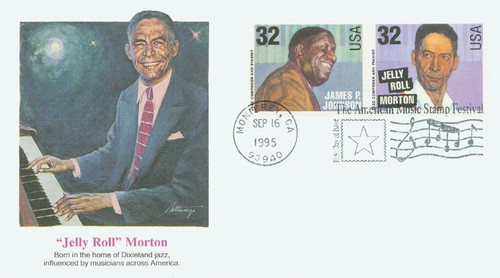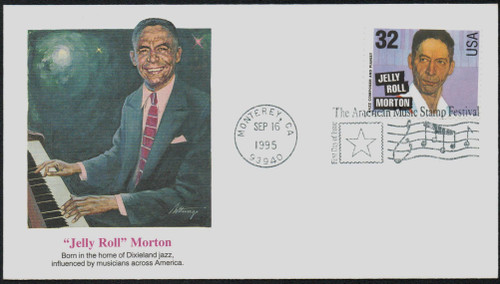
1995 Jazz Musicians-Morton (Johnson) FDC
# 2985-86 - 1995 Jazz Musicians-Morton (Johnson) FDC
$3.20
1995 32¢ James P. Johnson and Jelly Roll Morton
Jazz Musicians First Day Cover
Jazz Musicians First Day Cover
Issue Date: September 16, 1995
City: Monterey, CA
Printed By: Sterling Sommers for Ashton-Potter (USA) Ltd
Printing Method: Lithographed
Perforations: 11.1 x 11
Color: Multicolored
City: Monterey, CA
Printed By: Sterling Sommers for Ashton-Potter (USA) Ltd
Printing Method: Lithographed
Perforations: 11.1 x 11
Color: Multicolored
This Fleetwood First Day Cover features two stamps from the pane of 20 honoring jazz musicians. The Legends of American Music series began in 1993 and included country and western, popular singers, and rock ‘n’ roll.
James P. Johnson, one of America’s most noted jazz artists, was born February 1, 1894, in New Brunswick, New Jersey. Studying music as a child, he went on to play in local bands, and eventually toured Europe with the group Plantation Days. An innovative figure in American music, he combined elements of ragtime, blues, dance rhythms, and classical music to create the distinctive jazz piano style known as Harlem stride piano. Characterized by great rhythmic and harmonic development, often involving 10-note chords, this style creates a full, powerful sound. As the “father of stride piano,” Johnson strongly influenced such jazz greats as Count Basie, Duke Ellington, and Fats Waller.
Johnson’s ability to compose made him unique among his contemporaries. He wrote the scores for at least 16 musical shows during the 1920s. It was out of his 1923 Broadway production “Runnin’ Wild” that the tune and dance usually identified with the decade came – the Charleston. Many of his recordings have become jazz standards, including “If I Could Be With You,” “Snowy Morning Blues,” and “You Can’t Lose A Broken Heart.” Retiring to New York in the 1930s, he tackled his most ambitious goal, composing symphonic music based on African-American themes. Johnson died in 1955.
Jelly Roll Morton was born Ferdinand Joseph La Menthe Morton in Gulfport, Louisiana on September 20, 1885. He began studying guitar at seven, and piano at nine. Within a few years he was playing piano professionally in brothels around New Orleans. Later Morton began traveling; he was heard in Memphis, St. Louis, Kansas City, and California.
Morton made his first recording in 1923. From 1926 to 1930 he recorded his definitive works with Morton’s Red Hot Peppers. This band included Kid Ory, Johnny and Baby Dodds, Omer Simeon, and many other notable musicians. Morton enjoyed his greatest success as a performer during the late 1920s. But by 1937 his fame had declined. In 1939 he returned to recording and made a partial comeback.
Jelly Roll Morton’s career is very well documented – and controversial. Some of this debate was spawned by Morton’s own bragging. He once made the lofty claim to have “invented jazz in 1902.” Most authorities agree that Morton made important contributions to jazz as a composer, arranger, pianist, soloist, and bandleader. The songs “King Porter Stomp,” “Kansas City Stomp,” and “Dead Man Blues” are among the most popular of his more than 150 jazz classics.
1995 32¢ James P. Johnson and Jelly Roll Morton
Jazz Musicians First Day Cover
Jazz Musicians First Day Cover
Issue Date: September 16, 1995
City: Monterey, CA
Printed By: Sterling Sommers for Ashton-Potter (USA) Ltd
Printing Method: Lithographed
Perforations: 11.1 x 11
Color: Multicolored
City: Monterey, CA
Printed By: Sterling Sommers for Ashton-Potter (USA) Ltd
Printing Method: Lithographed
Perforations: 11.1 x 11
Color: Multicolored
This Fleetwood First Day Cover features two stamps from the pane of 20 honoring jazz musicians. The Legends of American Music series began in 1993 and included country and western, popular singers, and rock ‘n’ roll.
James P. Johnson, one of America’s most noted jazz artists, was born February 1, 1894, in New Brunswick, New Jersey. Studying music as a child, he went on to play in local bands, and eventually toured Europe with the group Plantation Days. An innovative figure in American music, he combined elements of ragtime, blues, dance rhythms, and classical music to create the distinctive jazz piano style known as Harlem stride piano. Characterized by great rhythmic and harmonic development, often involving 10-note chords, this style creates a full, powerful sound. As the “father of stride piano,” Johnson strongly influenced such jazz greats as Count Basie, Duke Ellington, and Fats Waller.
Johnson’s ability to compose made him unique among his contemporaries. He wrote the scores for at least 16 musical shows during the 1920s. It was out of his 1923 Broadway production “Runnin’ Wild” that the tune and dance usually identified with the decade came – the Charleston. Many of his recordings have become jazz standards, including “If I Could Be With You,” “Snowy Morning Blues,” and “You Can’t Lose A Broken Heart.” Retiring to New York in the 1930s, he tackled his most ambitious goal, composing symphonic music based on African-American themes. Johnson died in 1955.
Jelly Roll Morton was born Ferdinand Joseph La Menthe Morton in Gulfport, Louisiana on September 20, 1885. He began studying guitar at seven, and piano at nine. Within a few years he was playing piano professionally in brothels around New Orleans. Later Morton began traveling; he was heard in Memphis, St. Louis, Kansas City, and California.
Morton made his first recording in 1923. From 1926 to 1930 he recorded his definitive works with Morton’s Red Hot Peppers. This band included Kid Ory, Johnny and Baby Dodds, Omer Simeon, and many other notable musicians. Morton enjoyed his greatest success as a performer during the late 1920s. But by 1937 his fame had declined. In 1939 he returned to recording and made a partial comeback.
Jelly Roll Morton’s career is very well documented – and controversial. Some of this debate was spawned by Morton’s own bragging. He once made the lofty claim to have “invented jazz in 1902.” Most authorities agree that Morton made important contributions to jazz as a composer, arranger, pianist, soloist, and bandleader. The songs “King Porter Stomp,” “Kansas City Stomp,” and “Dead Man Blues” are among the most popular of his more than 150 jazz classics.







